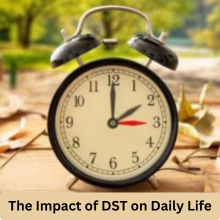
With the cool autumn air settling in, it’s almost that time again—time to turn back your clocks for Daylight Saving Time (DST). This yearly ritual, known for its catchy phrase “fall back,” can be a mixed bag of emotions for many. On one hand, it signals the cozy embrace of longer evenings; on the other, it can throw off sleep schedules and routines. So, what should you know about the end of DST in 2024? Let’s explore!
Understanding Daylight Saving Time
Daylight Saving Time is a practice that involves moving the clock forward in the spring and back in the fall to make better use of daylight. Introduced in the U.S. in 1918, its primary aim was to save energy during World War I. Over the years, it has evolved, but the core concept remains the same: more daylight during the evening hours.
When Does Daylight Saving Time End?
In 2024, DST will officially end on November 3. Clocks will go back one hour at 2 a.m. local time. It’s a good idea to set a reminder on your phone or calendar to change any clocks that don’t adjust automatically. Many people find it helpful to change their clocks right before bed, ensuring they wake up to the correct time on Sunday morning.
Global Perspective on DST
While many regions in the U.S. observe DST, the practice isn’t universal. For instance, the UK ends its DST on October 27, while countries like Australia have already begun DST, starting on October 6. Here’s a quick look at how different countries manage time changes:
- Europe: Most countries follow a similar schedule to the U.S. but usually end DST a week or two earlier.
- Australia: Regions vary significantly; some states observe DST, while others don’t.
Standard Time vs. Daylight Saving Time
What’s the difference between standard time and DST? Standard time refers to the typical clock settings used outside of DST periods. In contrast, DST involves advancing the clocks by an hour to maximize evening daylight. The distinction can be confusing, especially since most of the U.S. spends about 65% of the year in DST.
The Impact of DST on Daily Life
The shift to and from DST can disrupt sleep patterns significantly. Many people feel groggy or out of sync after the time change. A report from the American Academy of Sleep Medicine highlights that these transitions can lead to an increase in health issues, such as sleep disorders and even accidents.
Statistics and Facts About DST
Did you know that the average American experiences DST for 238 days each year? That’s a substantial portion of our lives spent adjusting to these time changes. The Uniform Time Act of 1966 was a significant step in establishing consistent DST rules, yet debates continue about whether the system is still effective today.
Will Time Changes Ever Disappear?
The question on many minds is: will we ever get rid of these time changes? Various proposals have been made, including the Sunshine Protection Act, which aimed to make DST permanent. Although the U.S. Senate passed this bill in 2022, it hasn’t yet progressed into law. The debate continues, with opinions split on whether year-round DST or standard time would be more beneficial.
Dealing with the Fall Back Transition
The “fall back” change is often viewed more favorably than the spring transition since it gives us an extra hour of sleep. However, that only works if you can afford to sleep in! Here are some tips to make the change easier:
- Adjust Gradually: Start going to bed and waking up 15 minutes earlier a few days before the change.
- Create a Sleep-Friendly Environment: Keep your room dark and cool to enhance sleep quality.
- Stay Active: Regular exercise can help regulate your sleep patterns.
The Science Behind Sleep and Time Changes
Our bodies operate on circadian rhythms, which are influenced by light and darkness. When we change our clocks, these rhythms can get thrown off. Sleep experts suggest maintaining a consistent sleep schedule throughout the year to minimize disruptions during time changes.
Also read: From Fitness Fame to Food Delivery: Susan Powter’s Fall
Long-Term Effects of DST
The long-term effects of DST on our health can be significant. Some studies suggest that the biannual time changes can lead to increased stress and anxiety. Moreover, maintaining a consistent daily routine is essential for our mental well-being.
Future of Daylight Saving Time
Public opinion is shifting, with many people advocating for a permanent end to the time changes. Surveys indicate that a substantial portion of the population prefers a consistent time year-round. As discussions continue, the future of DST remains uncertain, but it’s clear that change may be on the horizon.
What to Expect After the Change
After the clocks fall back, days will seem shorter as we head towards winter. Expect longer nights until the winter solstice on December 21, when daylight will gradually begin to return in the following months. For those eager for the return of longer evenings, mark March 9, 2025, on your calendar, when DST will resume.
Also read: Tragic Surfing Accident: 36-Year-Old Woman Impaled
Conclusion
As we prepare for the end of Daylight Saving Time in 2024, it’s essential to understand its implications on our daily lives. Embracing the change can help mitigate some of the disruptions that come with it. So, set your clocks back, enjoy that extra hour of sleep, and let’s look forward to the brighter days ahead!
FAQs
What happens when DST ends?
When DST ends, clocks are set back one hour, marking the return to standard time. This typically means darker afternoons.
Why was DST originally implemented?
DST was initially introduced to save energy and maximize daylight during the longer days of summer, especially during wartime.
Are there any health benefits to DST?
Some proponents argue that DST promotes outdoor activities in the evening, potentially improving mental health, but it can disrupt sleep patterns.
What states don’t observe DST?
Hawaii and most of Arizona do not observe DST, remaining on standard time throughout the year.
How can I cope with the time change better?
Gradually adjusting your sleep schedule, creating a conducive sleep environment, and maintaining a consistent routine can help ease the transition.

